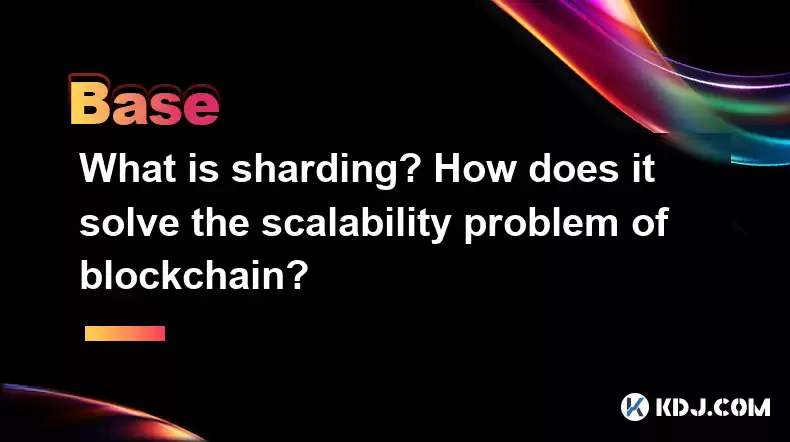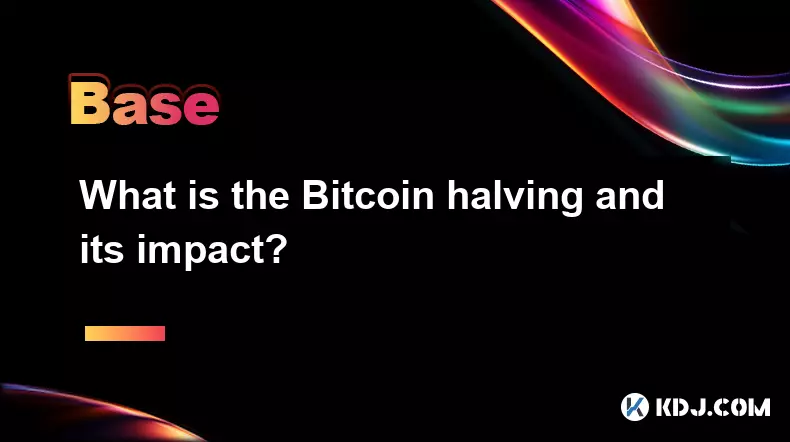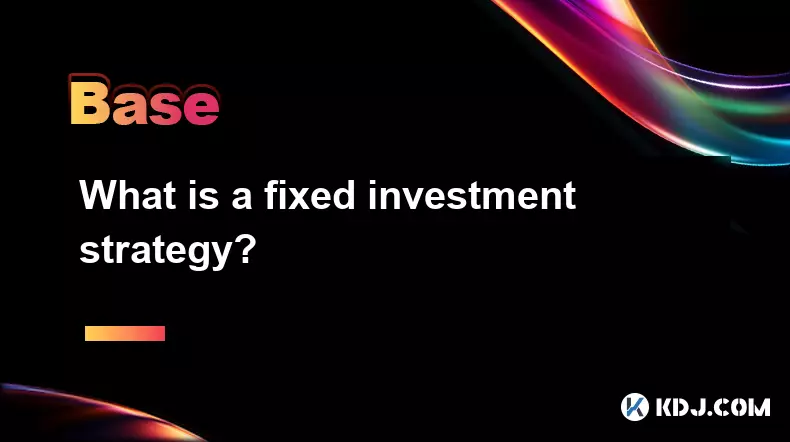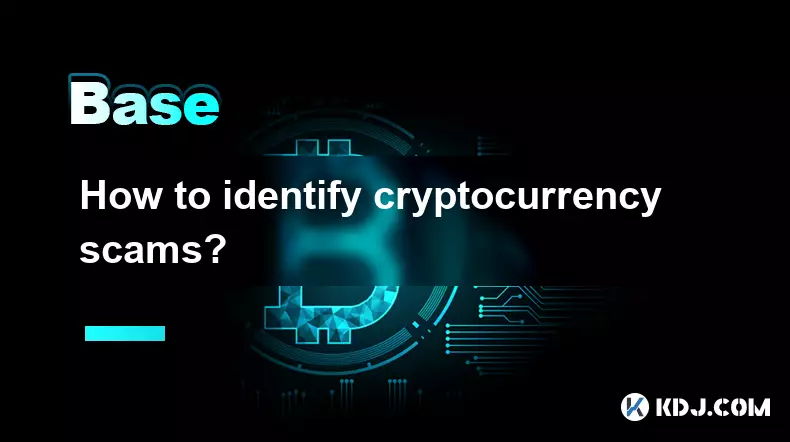-
 bitcoin
bitcoin $114698.945701 USD
-0.81% -
 ethereum
ethereum $4335.273830 USD
-3.42% -
 xrp
xrp $2.918728 USD
-2.33% -
 tether
tether $1.000596 USD
0.01% -
 bnb
bnb $1031.721802 USD
-2.41% -
 solana
solana $233.025110 USD
-3.06% -
 usd-coin
usd-coin $0.999931 USD
0.01% -
 dogecoin
dogecoin $0.249488 USD
-7.06% -
 tron
tron $0.338607 USD
-2.32% -
 cardano
cardano $0.865522 USD
-3.27% -
 hyperliquid
hyperliquid $49.793291 USD
-7.75% -
 chainlink
chainlink $22.343754 USD
-4.53% -
 ethena-usde
ethena-usde $1.000099 USD
-0.08% -
 avalanche
avalanche $31.768197 USD
-3.78% -
 sui
sui $3.521807 USD
-3.78%
What is sharding? How does it solve the scalability problem of blockchain?
Sharding enhances blockchain scalability by dividing the network into shards, allowing parallel transaction processing and reducing node load for increased efficiency.
Apr 06, 2025 at 03:08 am

Sharding is a key concept in the realm of blockchain technology designed to address one of its most pressing challenges: scalability. At its core, sharding involves breaking up a blockchain's database into smaller, more manageable pieces called shards. Each shard contains its own subset of data and transactions, and can process them independently of the other shards. This approach aims to enhance the overall throughput and efficiency of the blockchain network.
How Sharding Works
Sharding works by distributing the workload across multiple nodes in the network. Instead of every node having to process every transaction, which can lead to bottlenecks and slower transaction times, nodes are assigned to specific shards. This means that each node only needs to process the transactions within its designated shard. As a result, the network can handle a higher volume of transactions simultaneously, leading to improved scalability.
In a sharded blockchain, the network is divided into multiple shards, each maintaining its own state and transaction history. For example, if a blockchain is divided into 100 shards, each shard can process transactions independently, and the overall network can handle up to 100 times more transactions per second than a non-sharded blockchain. This division of labor allows the network to scale horizontally, meaning it can increase its capacity by adding more shards and nodes.
Benefits of Sharding
One of the primary benefits of sharding is increased transaction throughput. By allowing multiple shards to process transactions in parallel, the overall transaction capacity of the blockchain is significantly enhanced. This is crucial for applications that require high transaction speeds, such as decentralized finance (DeFi) platforms and gaming ecosystems.
Another significant advantage is reduced latency. In a non-sharded blockchain, every node must validate and process every transaction, which can lead to delays. Sharding reduces this burden by distributing the workload, resulting in faster transaction confirmation times. This improvement in latency can make blockchain networks more suitable for real-time applications.
Sharding also contributes to improved network efficiency. By allowing nodes to focus on a subset of the network's data, sharding reduces the storage and computational requirements for each node. This makes it easier for more nodes to participate in the network, further enhancing its decentralization and resilience.
Challenges and Considerations
Despite its benefits, sharding is not without its challenges. One of the primary concerns is maintaining network security. In a sharded blockchain, the network is divided into smaller parts, which could potentially be more vulnerable to attacks. To mitigate this risk, sharded blockchains often implement cross-shard communication protocols and consensus mechanisms that ensure the integrity of the entire network.
Another challenge is data consistency. Ensuring that transactions across different shards are processed correctly and that the overall state of the blockchain remains consistent requires sophisticated inter-shard communication and state synchronization mechanisms. These mechanisms must be carefully designed to prevent issues such as double-spending and to maintain the integrity of the blockchain.
Scalability trade-offs are also a consideration. While sharding can significantly improve transaction throughput, it may introduce additional complexity and overhead. The design and implementation of sharding solutions must balance these trade-offs to achieve the desired scalability without compromising the security and reliability of the blockchain.
Implementation Examples
Several blockchain projects have implemented or are exploring sharding as a solution to scalability. Ethereum 2.0, for example, is a major upgrade to the Ethereum network that includes a transition to a sharded architecture. In Ethereum 2.0, the network is divided into 64 shards, each capable of processing transactions independently. This upgrade aims to increase Ethereum's transaction capacity from around 15 transactions per second to potentially thousands of transactions per second.
Another example is Zilliqa, which was one of the first blockchain platforms to implement sharding at the protocol level. Zilliqa's sharding solution divides the network into multiple shards, each processing a subset of transactions. This approach has enabled Zilliqa to achieve higher transaction throughput compared to many other blockchain networks.
How Sharding Solves Scalability Issues
Sharding addresses the scalability problem of blockchain by allowing the network to process more transactions in parallel. This is achieved through the following mechanisms:
- Parallel Processing: By dividing the network into shards, transactions can be processed simultaneously across different shards, significantly increasing the overall transaction capacity.
- Reduced Node Load: Each node is responsible for processing transactions within its assigned shard, reducing the computational and storage requirements for individual nodes.
- Increased Network Capacity: As more shards are added to the network, the overall capacity of the blockchain increases, allowing it to handle a higher volume of transactions.
- Improved Latency: With fewer transactions to process per node, the time required to confirm transactions is reduced, leading to faster transaction times.
By implementing these mechanisms, sharding enables blockchain networks to scale more effectively, making them more suitable for a wide range of applications that require high transaction throughput and low latency.
Frequently Asked Questions
Q: Can sharding be implemented on any blockchain?A: Sharding can be implemented on many blockchains, but it requires significant changes to the underlying protocol. Not all blockchains are designed to support sharding, and the implementation can be complex and challenging. Projects like Ethereum and Zilliqa have successfully implemented sharding, but each blockchain must be evaluated on a case-by-case basis to determine its suitability for sharding.
Q: How does sharding affect the decentralization of a blockchain?A: Sharding can potentially impact the decentralization of a blockchain. While it allows more nodes to participate by reducing the workload per node, it also introduces new complexities in maintaining network consensus and security. Proper implementation of sharding solutions must balance these factors to ensure that the network remains decentralized and secure.
Q: What are the main differences between sharding and other scalability solutions like layer-2 scaling?A: Sharding is a layer-1 scaling solution that modifies the underlying blockchain protocol to increase its capacity. In contrast, layer-2 scaling solutions, such as sidechains and state channels, operate on top of the existing blockchain and process transactions off-chain before settling them on the main blockchain. Sharding directly increases the blockchain's transaction throughput, while layer-2 solutions aim to reduce the load on the main chain by processing transactions elsewhere.
Q: Are there any risks associated with sharding?A: Yes, there are several risks associated with sharding. These include potential vulnerabilities in cross-shard communication, challenges in maintaining data consistency across shards, and the complexity of implementing and maintaining sharding solutions. Proper design and rigorous testing are essential to mitigate these risks and ensure the security and reliability of a sharded blockchain.
Disclaimer:info@kdj.com
The information provided is not trading advice. kdj.com does not assume any responsibility for any investments made based on the information provided in this article. Cryptocurrencies are highly volatile and it is highly recommended that you invest with caution after thorough research!
If you believe that the content used on this website infringes your copyright, please contact us immediately (info@kdj.com) and we will delete it promptly.
- XRP Price, Settlement, and Lawsuit: What's Next for the Token?
- 2025-09-23 05:45:15
- XRP, Litecoin, BlockDAG: The Crypto Landscape Shift
- 2025-09-23 05:25:12
- Dogecoin, Price, and the ETF Buzz: What's the Deal?
- 2025-09-23 03:45:11
- Keeta Token's Mainnet Launch Sparks Token Rally: A New Era for DeFi?
- 2025-09-23 02:25:12
- Cryptos in 2025: Bittensor, Kaspa, and the Quest for Clarity
- 2025-09-23 03:05:16
- XDC Network's Tightrope Walk: Sell Walls and the $0.07 Line
- 2025-09-23 03:05:16
Related knowledge

Is there a finite supply of Bitcoin?
Sep 23,2025 at 06:00am
Bitcoin's Fixed Supply Mechanism1. Bitcoin was designed with a hard cap of 21 million coins, making its supply finite and predictable. This limit is h...

How are cryptocurrency transactions taxed?
Sep 23,2025 at 04:36am
Taxation of Cryptocurrency TransactionsCryptocurrency transactions are subject to various tax regulations depending on jurisdiction, usage, and freque...

What is the Bitcoin halving and its impact?
Sep 21,2025 at 08:18am
Understanding the Bitcoin Halving Mechanism1. The Bitcoin halving is a pre-programmed event that occurs approximately every four years, or after every...

How to evaluate a project's community activity?
Sep 22,2025 at 03:20am
Understanding the Role of Community in Crypto Projects1. A project's community serves as its backbone, influencing adoption, resilience during market ...

What is a fixed investment strategy?
Sep 22,2025 at 09:36am
Understanding Fixed Investment Strategies in the Crypto MarketA fixed investment strategy refers to a systematic approach where an investor allocates ...

How to identify cryptocurrency scams?
Sep 22,2025 at 02:36am
Understanding Common Types of Cryptocurrency Scams1. Fake initial coin offerings (ICOs) are among the most prevalent forms of crypto scams. Scammers c...

Is there a finite supply of Bitcoin?
Sep 23,2025 at 06:00am
Bitcoin's Fixed Supply Mechanism1. Bitcoin was designed with a hard cap of 21 million coins, making its supply finite and predictable. This limit is h...

How are cryptocurrency transactions taxed?
Sep 23,2025 at 04:36am
Taxation of Cryptocurrency TransactionsCryptocurrency transactions are subject to various tax regulations depending on jurisdiction, usage, and freque...

What is the Bitcoin halving and its impact?
Sep 21,2025 at 08:18am
Understanding the Bitcoin Halving Mechanism1. The Bitcoin halving is a pre-programmed event that occurs approximately every four years, or after every...

How to evaluate a project's community activity?
Sep 22,2025 at 03:20am
Understanding the Role of Community in Crypto Projects1. A project's community serves as its backbone, influencing adoption, resilience during market ...

What is a fixed investment strategy?
Sep 22,2025 at 09:36am
Understanding Fixed Investment Strategies in the Crypto MarketA fixed investment strategy refers to a systematic approach where an investor allocates ...

How to identify cryptocurrency scams?
Sep 22,2025 at 02:36am
Understanding Common Types of Cryptocurrency Scams1. Fake initial coin offerings (ICOs) are among the most prevalent forms of crypto scams. Scammers c...
See all articles










































































